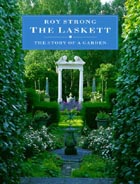Book Review: The Laskett
The Laskett, Roy Strong's tale of a garden of love and hope is a masterpiece, says Clive Aslet.


This is the story of a garden. It is also a story about love. Theatre designer Julia Trevelyan Oman has since passed away, but the book opens with Sir Roy's 'elopement' with her (an elopement that deemed necessary to escape the press; at the ages of 35 and 40, they were unlikely to be pursued by irate parents). The evolution of their garden at The Laskett, their rectory-like house in Herefordshire, is a monument to the love they had had for each other and the friendships they had enjoyed with other people.
From the beginning, Sir Roy knew that it would be a garden of sentiment, where plants evoked memories of people and places: a rosemary bush descended from one that belonged to Dr Trevelyan Oman's nanny, 'Dooks'; a catalpa given as a house-warming present by Lord Plunket (it died; the replacement is known as the 2nd Lord Plunket); even a flowering cherry, given by the father whom Sir Roy detested, planted in a remote corner surrounded by conifers, obstinately refusing to die. Work began soon after the couple's wedding in 1973.
Every time a new book or new stage production brought an influx of funds, some long-planned garden project would be fulfilled. Consequently, professional milestones are commemorated in such features as the Die Fledermaus Walk, the Nutcracker Garden and the Shakespeare Monument (built with the money that went with the Shakespeare Prize, which the author received in 1980). There are areas dedicated to favourite cats, statuary inherited from Dr Trevelyan Oman's father, and 'Flora'- a 'second' of one of the four cast-stone Seasons, commissioned from Italy for the Prince of Wales's garden at Highgrove.
The key to the garden is a temple constructed after Sir Roy left the Victoria and Albert Museum in 1987, after 13 years as director. A Greek inscription translates as: 'Memory, Mother of the Muses'. Not only did the muses live in a museum, but the garden reads as a kind of autobiography, shaped by memories shared by the creators. To underline the point, bushes of rosemary, for remembrance, grow over the steps. The Laskett is a unique document of our time.
And as this book demonstrates, the document is supported by a full apparatus criticus of reference material, since every nurseryman's invoice, friend's letter and snapshot seems to have been saved. In addition, any major event to have taken place in the garden was described in Sir Roy's diary. Through this wealth of first-hand evidence, the reader seems to live through every drama and inspiration as it strikes. There have been disasters - drought, box disease, the gardener's accidental devastation of a yew hedge which took 23 years to grow - but, next to Love, the presiding deity of the garden is Hope.
Understandably, the author and his wife were proud that no less an authority than their old friend Rosemary Verey should have considered The Laskett to be the largest formal garden created in Britain since the Second World War. This book traces its origin and influences, from old books on topiary to travels in Italy, from John Piper to Derek Jarman.
In the remarkable gardening partnership that the couple had formed, Dr Trevelyan Oman was the plantswoman, holding total sway over areas such as the kitchen garden. Sir Roy, evidently frustrated that childhood circumstances did not allow him to become an artist, is preoccupied by the design.
Exquisite houses, the beauty of Nature, and how to get the most from your life, straight to your inbox.
There was once talk of a Random House, a zany architectural caprice to remember the publisher of one of Sir Roy's books. Perhaps this book will be commemorated by a run of little hens (although they would have to keep out of the way of the cats).
The Laskett has always evolved at a pace that would long ago have exhausted less committed gardeners. Occasionally, though, even these two allowed themselves a short break from their task of ceaseless creation. Sir Roy describes how they would sit together in the Victoria and Albert Museum Temple, not saying very much, just watching their garden grow. Ian Hamilton Finlay, whose garden of ideas at Little Sparta struck Sir Roy with the force of 'a Pauline conversion', likened the couple once to Adam and Eve. The reader can now share their paradise of love and hope.
Country Life is unlike any other magazine: the only glossy weekly on the newsstand and the only magazine that has been guest-edited by His Majesty The King not once, but twice. It is a celebration of modern rural life and all its diverse joys and pleasures — that was first published in Queen Victoria's Diamond Jubilee year. Our eclectic mixture of witty and informative content — from the most up-to-date property news and commentary and a coveted glimpse inside some of the UK's best houses and gardens, to gardening, the arts and interior design, written by experts in their field — still cannot be found in print or online, anywhere else.
